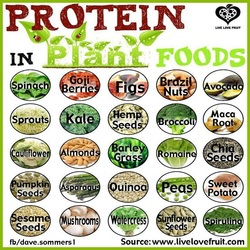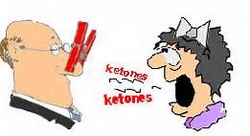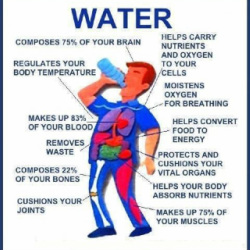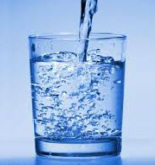Where Do You Get Your Protein?

The Protein Craze
Over the past decade, high protein diet fads have flooded the media and market, advertised for weight loss, increasing muscle mass/strength, and controlling certain health conditions. They come with names like the Atkins diet, the South Beach diet, the Zone diet, and most recently, the Paleo diet. We are bombarded with ads for high protein shakes, high protein bars, high protein yogurt, and even high protein bread. You would think that with all the emphasis on high protein diets, the American health epidemic must be due to widespread protein deficiency. The truth of the matter is that the average American actually consumes DOUBLE the recommended daily allowance (RDA) for protein!
Research suggests that consuming over 30% of your daily caloric intake from protein can place added stress on internal organs such as the kidneys, liver, and heart. One of the biggest misconceptions is that more protein is needed for muscle growth while weight training. The only criteria for building strong muscles is proper and consistent training, as well as meeting the caloric needs for your body and activity level. Consider our friend the gorilla, his diet is 100% plant-based (aside from the occasional bug). He doesn't require massive amounts of protein to support his 400 pound frame, just massive amounts of plant food. Excess protein in the diet actually hinders muscle gain (because the body has to work to filter it out)! The largest amount of human growth occurs during infancy; a mother's breast milk contains only 6% protein and is able to support the extreme energy demands of the growing child. Clinically speaking, a protein deficiency only occurs in the presence of a calorically insufficient diet. In order to meet our daily protein requirements, we have to eat enough food!
Over the past decade, high protein diet fads have flooded the media and market, advertised for weight loss, increasing muscle mass/strength, and controlling certain health conditions. They come with names like the Atkins diet, the South Beach diet, the Zone diet, and most recently, the Paleo diet. We are bombarded with ads for high protein shakes, high protein bars, high protein yogurt, and even high protein bread. You would think that with all the emphasis on high protein diets, the American health epidemic must be due to widespread protein deficiency. The truth of the matter is that the average American actually consumes DOUBLE the recommended daily allowance (RDA) for protein!
Research suggests that consuming over 30% of your daily caloric intake from protein can place added stress on internal organs such as the kidneys, liver, and heart. One of the biggest misconceptions is that more protein is needed for muscle growth while weight training. The only criteria for building strong muscles is proper and consistent training, as well as meeting the caloric needs for your body and activity level. Consider our friend the gorilla, his diet is 100% plant-based (aside from the occasional bug). He doesn't require massive amounts of protein to support his 400 pound frame, just massive amounts of plant food. Excess protein in the diet actually hinders muscle gain (because the body has to work to filter it out)! The largest amount of human growth occurs during infancy; a mother's breast milk contains only 6% protein and is able to support the extreme energy demands of the growing child. Clinically speaking, a protein deficiency only occurs in the presence of a calorically insufficient diet. In order to meet our daily protein requirements, we have to eat enough food!

What is protein?
Protein is a large macro-molecule comprised of amino acids, which are nitrogen-containing compounds found within every cell. The element nitrogen makes protein unique compared to the other macronutrients (carbohydrates and fats). Amino acids serve major functional roles within the body. They work as enzymes, hormones, structural components (DNA, skin, hair, nails, blood), immuno-protectors, transporters, buffers, and fluid balancers. There are 22 amino acids in total, 9 of which are essential, meaning they must be supplied by the diet because the body cannot manufacture them on its own. The 9 essential amino acids are tryptophan, lysine, methionine, valine, leucine, isoleucine, threonine, phenylalanine, and histidine.
Protein Requirements
The mainstream dieting industry pushes protein as the most important component of the human diet, but if we were to consider our total body mass, nitrogen only accounts for 3% compared to oxygen 65%, and carbon 18.5%. The recommended daily allowance (RDA) for protein according to US government standards is 46 grams/day for women and 56 grams/day for men. These figures account for roughly 9% of the total daily caloric intake (based on a 2000 calorie diet for women, and 2500 calorie diet for men). The World Health Organization suggests a daily protein intake of 2.5-10% of total calories.
My general recommendation is to get 20% or less of your daily protein from predominantly plant-based sources. This will ensure that you are able to meet your daily protein requirements, but are not over-consuming protein.
Protein is a large macro-molecule comprised of amino acids, which are nitrogen-containing compounds found within every cell. The element nitrogen makes protein unique compared to the other macronutrients (carbohydrates and fats). Amino acids serve major functional roles within the body. They work as enzymes, hormones, structural components (DNA, skin, hair, nails, blood), immuno-protectors, transporters, buffers, and fluid balancers. There are 22 amino acids in total, 9 of which are essential, meaning they must be supplied by the diet because the body cannot manufacture them on its own. The 9 essential amino acids are tryptophan, lysine, methionine, valine, leucine, isoleucine, threonine, phenylalanine, and histidine.
Protein Requirements
The mainstream dieting industry pushes protein as the most important component of the human diet, but if we were to consider our total body mass, nitrogen only accounts for 3% compared to oxygen 65%, and carbon 18.5%. The recommended daily allowance (RDA) for protein according to US government standards is 46 grams/day for women and 56 grams/day for men. These figures account for roughly 9% of the total daily caloric intake (based on a 2000 calorie diet for women, and 2500 calorie diet for men). The World Health Organization suggests a daily protein intake of 2.5-10% of total calories.
My general recommendation is to get 20% or less of your daily protein from predominantly plant-based sources. This will ensure that you are able to meet your daily protein requirements, but are not over-consuming protein.
Protein Sources
Ironically, the majority of our protein needs are met by internal protein sources. The human body actually recycles and reuses a considerable amount of protein (70-100 grams) per day as endogenous protein. Endogenous protein comes from internal protein sources, such as desquamated mucoasal cells (50 g/day), digestive enzymes, and glycoproteins.
The reminder of our protein needs are met by exogenous protein sources. Exogenous, or external protein sources can be found within the foods we consume on a daily basis. These protein sources cannot be absorbed directly, and must be mechanically broken down (via enzymes) to their amino acid counterparts. These amino acids are then absorbed and reformed into the necessary protein structures based on body demands. The main external proteins required by the human body are the 9 essential amino acids. Essential indicates that we cannot make them ourselves, and must obtain the amino acids through our diet. The essential amino acids can be found in all whole foods, including plants!
External protein sources can be separated into two categories: animal based sources and plant based sources.
Ironically, the majority of our protein needs are met by internal protein sources. The human body actually recycles and reuses a considerable amount of protein (70-100 grams) per day as endogenous protein. Endogenous protein comes from internal protein sources, such as desquamated mucoasal cells (50 g/day), digestive enzymes, and glycoproteins.
The reminder of our protein needs are met by exogenous protein sources. Exogenous, or external protein sources can be found within the foods we consume on a daily basis. These protein sources cannot be absorbed directly, and must be mechanically broken down (via enzymes) to their amino acid counterparts. These amino acids are then absorbed and reformed into the necessary protein structures based on body demands. The main external proteins required by the human body are the 9 essential amino acids. Essential indicates that we cannot make them ourselves, and must obtain the amino acids through our diet. The essential amino acids can be found in all whole foods, including plants!
External protein sources can be separated into two categories: animal based sources and plant based sources.

Animal-based Protein Sources: Meat, Poultry, Fish, Eggs, and Dairy
The main issue with consuming animal-based protein sources is that they are high in protein AND fat, as well as saturated fat, cholesterol, sodium, heterocyclic amines, and polycyclic aromatic hydrocarbons (linked to cancer formation). The average 8 oz. New York strip steak contains a whopping 65 grams of protein, 450 calories, 11 grams of saturated fat, 150 mg of cholesterol, and 0 grams of fiber. The protein content of this steak is well above the recommended daily allowance (RDA) for a woman or a man. The saturated fat and cholesterol content of the steak are both over 50% of the RDA for an individual consuming a 2500 calorie diet. The lack of fiber also makes the steak very difficult to remove from the body, increasing risk of colon cancer and other gastrointestinal diseases.
It's interesting to note that animal-based foods are actually lower in protein per calories compared to certain plant-based foods. When consumed, animal-based protein cause a systemic inflammatory condition that leaches precious alkaline minerals (like calcium and phosphorus) from the body (primarily bones) to buffer the acidity! Excess animal protein consumption has been linked to nutritional imbalances, chronic inflammation, obesity, diabetes, heart disease, several types of cancer, osteoporosis, high blood pressure, Alzhiemer's disease, gastrointestinal disorders, hormonal imbalances, lowered immune function, lymphatic disorders (fibromyalgia, endometrosis), acne, hair loss, impotence, premature aging, dehydration, arthritis, depression/anxiety, insomnia, and liver/kidney disease. To prevent disease, it is recommended to include no more than 10% daily calories from animal-based foods.
Also, it's important to understand that animal based protein are actually secondary sources of protein. Herbivorous animals obtain their protein from plant-based sources (ie/ cow eating grass). There is not one nutrient that humans can't manufacture themselves or acquire from plant-based foods!
The main issue with consuming animal-based protein sources is that they are high in protein AND fat, as well as saturated fat, cholesterol, sodium, heterocyclic amines, and polycyclic aromatic hydrocarbons (linked to cancer formation). The average 8 oz. New York strip steak contains a whopping 65 grams of protein, 450 calories, 11 grams of saturated fat, 150 mg of cholesterol, and 0 grams of fiber. The protein content of this steak is well above the recommended daily allowance (RDA) for a woman or a man. The saturated fat and cholesterol content of the steak are both over 50% of the RDA for an individual consuming a 2500 calorie diet. The lack of fiber also makes the steak very difficult to remove from the body, increasing risk of colon cancer and other gastrointestinal diseases.
It's interesting to note that animal-based foods are actually lower in protein per calories compared to certain plant-based foods. When consumed, animal-based protein cause a systemic inflammatory condition that leaches precious alkaline minerals (like calcium and phosphorus) from the body (primarily bones) to buffer the acidity! Excess animal protein consumption has been linked to nutritional imbalances, chronic inflammation, obesity, diabetes, heart disease, several types of cancer, osteoporosis, high blood pressure, Alzhiemer's disease, gastrointestinal disorders, hormonal imbalances, lowered immune function, lymphatic disorders (fibromyalgia, endometrosis), acne, hair loss, impotence, premature aging, dehydration, arthritis, depression/anxiety, insomnia, and liver/kidney disease. To prevent disease, it is recommended to include no more than 10% daily calories from animal-based foods.
Also, it's important to understand that animal based protein are actually secondary sources of protein. Herbivorous animals obtain their protein from plant-based sources (ie/ cow eating grass). There is not one nutrient that humans can't manufacture themselves or acquire from plant-based foods!

Plant-based Protein Sources: Legumes/Beans, Nuts/Seeds, Whole Grains, Vegetables, Fruits
One of the major differences between plant-based protein and animal-based protein is fiber. Fiber is a very special dietary component that is responsible for the movement of food through the digestive tract as well as the removal of undigested food stuffs (including protein and fat) from the body. Without sufficient fiber, the foods that we consume can remain trapped in the digestive tract for days, weeks, months, and even years, increasing our risk for colon cancer and other gastrointestinal diseases.
The advantages of consuming plants to meet protein requirements are extensive. Plant-based foods contain more nutrients, antioxidant phytochemicals, water, fiber, and alkaline minerals (potassium, calcium, magnesium) than animal-based foods, and are easier to digest, absorb, assimilate, and eliminate.
Plant-based protein sources can be divided into two categories: concentrated and un-concentrated. Concentrated plant-based protein sources include beans/legumes, some grains (quinoa, oats), nuts, and seeds. These foods contain higher levels of protein than un-concentrated sources. For example, 1 cup of cooked black beans contains 18 grams of protein, and 15 grams of fiber.
Un-concentrated plant-based protein sources include starchy vegetables (potatoes, yams, carrots), grains (rice, corn, millet), non-starchy vegetables (green leafy vegetables, asparagus, sprouts, mushrooms), and fruits (figs, citrus, berries). These foods contain higher levels of water, fiber, and carbohydrates by weight and are typically low in fat and protein. Contrary to popular belief, fruit actually contains the most bio-available amino acids because fruit is the easiest and quickest food for the human body to digest (as long as the fruit is ripe). Even if you only consumed fruits and vegetables, you can still meet your protein requirements as long as you consume enough calories from those foods!
Plant-based protein supplements are also available if the dietary intake of protein is insufficient. Hemp protein is one of the best protein supplements on the market, containing all 9 essential amino acids, essential fatty acids, magnesium, iron, and fiber. Roughly 98% percent of the protein available in hemp can be digested and utilized by the human body. Other supplemental plant-protein sources include pea and rice proteins.
One of the major differences between plant-based protein and animal-based protein is fiber. Fiber is a very special dietary component that is responsible for the movement of food through the digestive tract as well as the removal of undigested food stuffs (including protein and fat) from the body. Without sufficient fiber, the foods that we consume can remain trapped in the digestive tract for days, weeks, months, and even years, increasing our risk for colon cancer and other gastrointestinal diseases.
The advantages of consuming plants to meet protein requirements are extensive. Plant-based foods contain more nutrients, antioxidant phytochemicals, water, fiber, and alkaline minerals (potassium, calcium, magnesium) than animal-based foods, and are easier to digest, absorb, assimilate, and eliminate.
Plant-based protein sources can be divided into two categories: concentrated and un-concentrated. Concentrated plant-based protein sources include beans/legumes, some grains (quinoa, oats), nuts, and seeds. These foods contain higher levels of protein than un-concentrated sources. For example, 1 cup of cooked black beans contains 18 grams of protein, and 15 grams of fiber.
Un-concentrated plant-based protein sources include starchy vegetables (potatoes, yams, carrots), grains (rice, corn, millet), non-starchy vegetables (green leafy vegetables, asparagus, sprouts, mushrooms), and fruits (figs, citrus, berries). These foods contain higher levels of water, fiber, and carbohydrates by weight and are typically low in fat and protein. Contrary to popular belief, fruit actually contains the most bio-available amino acids because fruit is the easiest and quickest food for the human body to digest (as long as the fruit is ripe). Even if you only consumed fruits and vegetables, you can still meet your protein requirements as long as you consume enough calories from those foods!
Plant-based protein supplements are also available if the dietary intake of protein is insufficient. Hemp protein is one of the best protein supplements on the market, containing all 9 essential amino acids, essential fatty acids, magnesium, iron, and fiber. Roughly 98% percent of the protein available in hemp can be digested and utilized by the human body. Other supplemental plant-protein sources include pea and rice proteins.

Ketosis and High Protein Diets
Chronically exceeding daily protein requirements can cause a metabolic disturbance in the way energy to created in the body (aka metabolism). When protein and fat intake exceeds carbohydrate intake, or if carbohydrate intake is insufficient, the body will revert to burning protein/fat for fuel (gluconeogenesis). Initially any excess ingested protein/fat are immediately stored (as fat) when carbohydrate intake is sufficient enough to meet energy demands. When someone partakes in a low carbohydrate diet, they begin to burn the stored fat/protein for fuel. This fat burning concept sounds grand (in theory), but the biochemical process of converting protein/fat into glucose (fuel) is a very energy taxing and inefficient- resulting in weight loss at the expensive of the metabolism
Once the body begins to utilize protein/fat for fuel, a toxic condition known as ketosis begins. Ketone bodies are the by-product of this reaction, and must be removed from the body immendiately due to their high level of toxicity. When a person is following a high protein/fat diet
(Atkins, South beach. Paleo, Ketogenic) one can literally smell the acidic ketones leaching out of them! The kidneys are responsible for filtering out these harmful waste products, drawing on internal water stores to dilute the toxins. This results in dehydration and the (water) weight loss associated with these diets. Metabolically, ketosis mimics starvation as the metabolic rate lowers in an effort to conserve fuel and prevent widespread damage. Once the individual reaches their breaking point on a high protein/low carbohydrate, ketogenic diet and begins to eat carbohydrates again, rapid weight gain will follow 100% of the time; to what degree depends on the extent of metabolic damage caused by the ketogenic diet. High protein/low carbohydrate, ketogenic diets have been linked to blood sugar imbalances, insulin resistance (diabetes), nutrient imbalances, hypothyroidism, high blood pressure, metabolic damage, depression/anxiety, kidney/liver disease, heart disease, cancer, gastrointestinal disorders (IBS, constipation, diverticulitis), inflammatory diseases, obesity, and premature aging.
Chronically exceeding daily protein requirements can cause a metabolic disturbance in the way energy to created in the body (aka metabolism). When protein and fat intake exceeds carbohydrate intake, or if carbohydrate intake is insufficient, the body will revert to burning protein/fat for fuel (gluconeogenesis). Initially any excess ingested protein/fat are immediately stored (as fat) when carbohydrate intake is sufficient enough to meet energy demands. When someone partakes in a low carbohydrate diet, they begin to burn the stored fat/protein for fuel. This fat burning concept sounds grand (in theory), but the biochemical process of converting protein/fat into glucose (fuel) is a very energy taxing and inefficient- resulting in weight loss at the expensive of the metabolism
Once the body begins to utilize protein/fat for fuel, a toxic condition known as ketosis begins. Ketone bodies are the by-product of this reaction, and must be removed from the body immendiately due to their high level of toxicity. When a person is following a high protein/fat diet
(Atkins, South beach. Paleo, Ketogenic) one can literally smell the acidic ketones leaching out of them! The kidneys are responsible for filtering out these harmful waste products, drawing on internal water stores to dilute the toxins. This results in dehydration and the (water) weight loss associated with these diets. Metabolically, ketosis mimics starvation as the metabolic rate lowers in an effort to conserve fuel and prevent widespread damage. Once the individual reaches their breaking point on a high protein/low carbohydrate, ketogenic diet and begins to eat carbohydrates again, rapid weight gain will follow 100% of the time; to what degree depends on the extent of metabolic damage caused by the ketogenic diet. High protein/low carbohydrate, ketogenic diets have been linked to blood sugar imbalances, insulin resistance (diabetes), nutrient imbalances, hypothyroidism, high blood pressure, metabolic damage, depression/anxiety, kidney/liver disease, heart disease, cancer, gastrointestinal disorders (IBS, constipation, diverticulitis), inflammatory diseases, obesity, and premature aging.
So what do you do now?
With all this information, you might be asking yourself, where do I start? A good place to go is www.cronometer.com so you can start tracking your current protein intake today. Aim for a daily protein intake of 5-20% of total consumed calories, with the majority coming from plant-based sources like beans/legumes, whole grains, nuts/seeds, vegetables, and fruits. If you find that you are consuming over 30% of your daily calories from protein, don't panic! Just start cutting back on the animal-based protein sources, and start adding more plant-based foods to your current diet. The key to success with any dietary change is to transition slowly, find what you like, and be patient!
Post a comment/question and share this information if you found it helpful!
Victoria
With all this information, you might be asking yourself, where do I start? A good place to go is www.cronometer.com so you can start tracking your current protein intake today. Aim for a daily protein intake of 5-20% of total consumed calories, with the majority coming from plant-based sources like beans/legumes, whole grains, nuts/seeds, vegetables, and fruits. If you find that you are consuming over 30% of your daily calories from protein, don't panic! Just start cutting back on the animal-based protein sources, and start adding more plant-based foods to your current diet. The key to success with any dietary change is to transition slowly, find what you like, and be patient!
Post a comment/question and share this information if you found it helpful!
Victoria













 RSS Feed
RSS Feed
